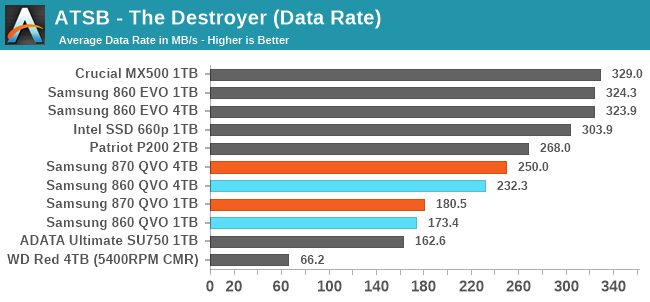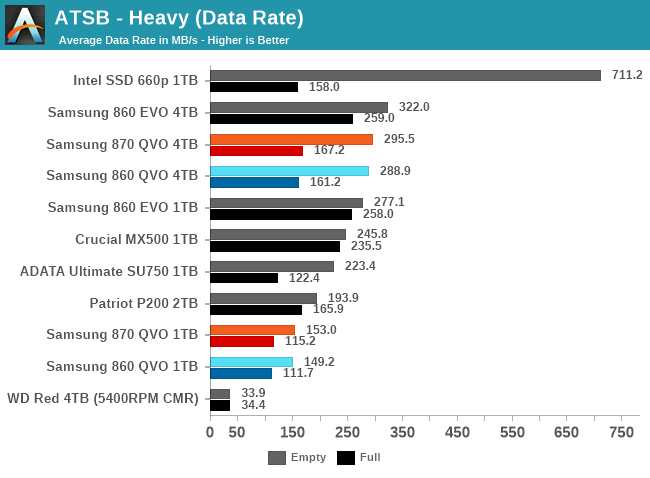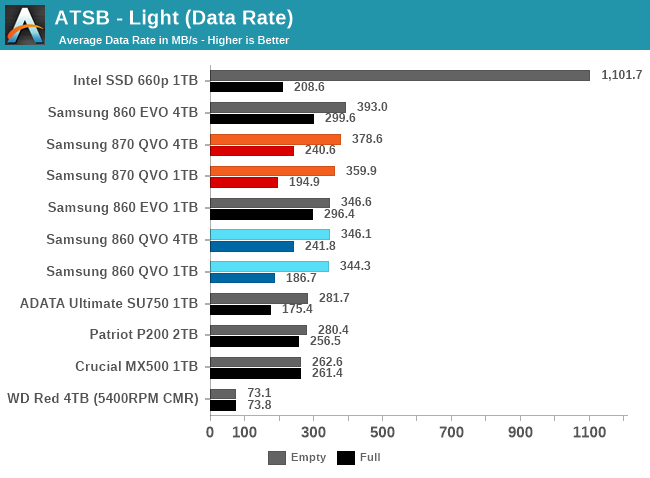The Samsung 870 QVO (1TB & 4TB) SSD Review: QLC Refreshed
by Billy Tallis on June 30, 2020 11:40 AM ESTAnandTech Storage Bench - The Destroyer
The Destroyer is an extremely long test replicating the access patterns of very IO-intensive desktop usage. A detailed breakdown can be found in this article. Like real-world usage, the drives do get the occasional break that allows for some background garbage collection and flushing caches, but those idle times are limited to 25ms so that it doesn't take all week to run the test. These AnandTech Storage Bench (ATSB) tests do not involve running the actual applications that generated the workloads, so the scores are relatively insensitive to changes in CPU performance and RAM from our new testbed, but the jump to a newer version of Windows and the newer storage drivers can have an impact.
We quantify performance on this test by reporting the drive's average data throughput, the average latency of the I/O operations, and the total energy used by the drive over the course of the test.
 |
|||||||||
| Average Data Rate | |||||||||
| Average Latency | Average Read Latency | Average Write Latency | |||||||
| 99th Percentile Latency | 99th Percentile Read Latency | 99th Percentile Write Latency | |||||||
| Energy Usage | |||||||||
The second-generation Samsung QLC drives offer slight performance increases over their predecessors on The Destroyer, but it's not enough to significantly change how a QVO rates against drives in other market segments. The 870 QVO is still trading wins against DRAMless SATA drives with TLC NAND, and clearly well behind the Intel QLC NVMe drive and the mainstream TLC SATA drives.
In general, the latency scores from the Samsung QVO drives are worse than from the DRAMless TLC drives, while the 4TB QVOs still have better overall throughput. The 1TB QVOs (both old and new) are prone to write latencies that are worse than the 5400RPM hard drive. Both capacities of the 870 QVO have worse read latency but better write latency scores than the 860 QVO.
Energy usage is a mixed bag. The 4TB 870 QVO is a slight improvement over its predecessor while the 1TB is a slight step backward. All of the QLC drives require substantially more energy to complete The Destroyer than mainstream TLC drives, and one of the DRAMless TLC drives comes out wa
AnandTech Storage Bench - Heavy
Our Heavy storage benchmark is proportionally more write-heavy than The Destroyer, but much shorter overall. The total writes in the Heavy test aren't enough to fill the drive, so performance never drops down to steady state. This test is far more representative of a power user's day to day usage, and is heavily influenced by the drive's peak performance. The Heavy workload test details can be found here. This test is run twice, once on a freshly erased drive and once after filling the drive with sequential writes.
 |
|||||||||
| Average Data Rate | |||||||||
| Average Latency | Average Read Latency | Average Write Latency | |||||||
| 99th Percentile Latency | 99th Percentile Read Latency | 99th Percentile Write Latency | |||||||
| Energy Usage | |||||||||
The Heavy test is quite a bit shorter than The Destroyer, so the scores show more impact from the peak performance of SLC caching. The 4TB Samsung QVOs offer overall performance that is competitive with mainstream TLC SATA drives, when the test is run on an empty drive and they get to make use of their full SLC cache sizes. Those conditions also allow the Intel 660p to show off its NVMe performance, but the 1TB Samsung QVOs have the smallest SLC caches and worst post-cache performance, and this test is long enough for that to become a problem. When the drives are filled before running the test, all of the QLC models fall short of the mainstream TLC drives.
Performance has again changed very little from the 860 QVO to the 870 QVO. A few of the latency scores have regressed slightly, but not by enough to matter. Both capacities of the 870 QVO manage to outperform the hard drive on every performance metric; write latency comes close for the smaller, slower 870 QVO, but the read latency scores are all several times better than the hard drive can manage.
The 870 QVO still requires a lot more energy to complete the test than more high-end TLC-based drives. This mostly comes down to extra energy used as a result of the test taking longer, with write operations having the biggest impact. The 4TB QVO is again more efficient than the slower 1TB model.
AnandTech Storage Bench - Light
Our Light storage test has relatively more sequential accesses and lower queue depths than The Destroyer or the Heavy test, and it's by far the shortest test overall. It's based largely on applications that aren't highly dependent on storage performance, so this is a test more of application launch times and file load times. This test can be seen as the sum of all the little delays in daily usage, but with the idle times trimmed to 25ms it takes less than half an hour to run. Details of the Light test can be found here. As with the ATSB Heavy test, this test is run with the drive both freshly erased and empty, and after filling the drive with sequential writes.
 |
|||||||||
| Average Data Rate | |||||||||
| Average Latency | Average Read Latency | Average Write Latency | |||||||
| 99th Percentile Latency | 99th Percentile Read Latency | 99th Percentile Write Latency | |||||||
| Energy Usage | |||||||||
The Light test really highlights the benefits of putting a high-end SSD controller in an otherwise entry-level product. Samsung's controllers set the bar, and on lighter workloads like this test the QLC NAND doesn't drag the 870 QVO down to the level of non-Samsung SATA drives unless the test is run on a full drive. However, such a light workload also puts the NVMe competition in its best possible light where the Intel 660p is three times faster overall.
Latency does still spike for the full-drive test runs on the QLC drives, especially when looking at 99th percentile latencies. But unlike the Intel 660p, those spikes aren't bad enough to bring the worst-case latencies of the Samsung QVOs up to hard drive levels of lag.
Aside from the extra energy used by the QLC drives on the full-drive test runs, the energy usage differences between SSDs on this test are pretty minor, and the 870 QVO shows no meaningful change from the 860 QVO.










64 Comments
View All Comments
akramargmail - Tuesday, June 30, 2020 - link
So this is better for Samsung, but not for me. Never wanted the 860 QVO and see no reason to change my mind.yeeeeman - Tuesday, June 30, 2020 - link
I agree. Samsung is losing a big chance with this line of SSDs by pricing them very high for what they can do and what competition they have.Urwni - Tuesday, June 30, 2020 - link
Yeah, 860 EVO is still competitive, considering its price, performance and reliability.Great_Scott - Thursday, July 2, 2020 - link
Ahhh. The late great 870 QVO. Perfect match in price and (mostly) performance with major mfr TLC drives.It has no reason to exist at the price point it's sold at. A shame.
B Huggy - Monday, July 6, 2020 - link
"So this is better for Samsung, but not for me. Never wanted the 860 QVO and see no reason to change my mind."Love it - you don't even own it, but somehow it's bad for you. :D
shabby - Tuesday, June 30, 2020 - link
Approaching hdd speeds... congrats samsung 👏👏👏leexgx - Sunday, July 5, 2020 - link
For £0-10 saving I can get this QLC drive (£90 new), just not worth it for the possible slow down compared to a Samsung evo or Crucial mx500 (£90 to £100 new, or less used)Needs to be significantly cheaper
Jorgp2 - Tuesday, June 30, 2020 - link
Those prices are terribleSomeguyperson - Tuesday, June 30, 2020 - link
As Anand said, "There are no bad products, only bad prices".Jorgp2 - Tuesday, June 30, 2020 - link
Whereas Linus says, "It's a bad product if it will get me clicks".